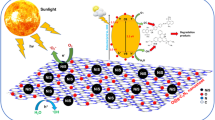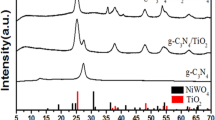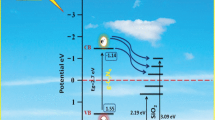Abstract
In this study, a novel photocatalyst comprising graphitic carbon nitride (g-C3N4) and tungsten oxide (WO3) in different weight ratios was fabricated through a facile synthesis method. The synthesized nanocomposites were characterized using various techniques including X-ray diffraction (XRD), scanning electron microscopy (SEM), transmission electron microscopy (TEM), and UV–vis spectroscopy to elucidate their structural and optical properties. The photocatalytic performance of the g-C3N4/WO3 nanocomposite was evaluated for Rhodamine (RhB) degradation under visible light irradiation. Remarkably, the 3 wt % g-C3N4/WO3 nanocomposite exhibited a superior degradation efficiency of 96% (rate constant ~ 0.02714 min−1) compared to pure g-C3N4 and WO3. The major role was played by both holes (h+) and superoxide anion radicals (•O2−) in the degradation process. This performance is attributed to the synergistic effect between the two components, which facilitated efficient charge separation leading to decreased recombination of photo-generated electron–hole pairs, and improved light absorption. Additionally, the optimized nanocomposite was employed for electrochemical detection of 2-nitrophenol (2-NP), showcasing remarkable sensitivity (limit of detection ~ 0.22 µM) and selectivity towards 2-NP. This positions it as a promising candidate for environmental monitoring applications. In summary, this study underscores the potential of the g-C3N4/WO3 nanocomposite in wastewater treatment as a visible light photocatalyst, alongside its utility in electrochemical sensing of organic pollutants.
Graphical Abstract















Similar content being viewed by others
Data Availability
Upon a reasonable request, the datasets generated and analyzed in the course of the present study are available from the corresponding authors.
References
Lanjwani MF, Tuzen M, Khuhawar MY, Saleh TA (2024) Trends in photocatalytic degradation of organic dye pollutants using nanoparticles: a review. Inorg Chem Commun 159:111613
Rafiq A, Ikram M, Ali S, Niaz F, Khan M, Khan Q, Maqbool M (2021) Photocatalytic degradation of dyes using semiconductor photocatalysts to clean industrial water pollution. J Ind Eng Chem 97:111–128
Zhu D, Zhou Q (2019) Action and mechanism of semiconductor photocatalysis on degradation of organic pollutants in water treatment: a review. Environ Nanotechnol, Monit Manag 12:100255
Wang H, Zhang L, Chen Z, Hu J, Li S, Wang Z, Liu J, Wang X (2014) Semiconductor heterojunction photocatalysts: design, construction, and photocatalytic performances. Chem Soc Rev 43(15):5234–5244
Nemiwal M, Zhang TC, Kumar D (2021) Recent progress in g-C3N4, TiO2 and ZnO based photocatalysts for dye degradation: strategies to improve photocatalytic activity. Sci Total Environ 767:144896
Karthikeyan C, Arunachalam P, Ramachandran K, Al-Mayouf AM, Karuppuchamy S (2020) Recent advances in semiconductor metal oxides with enhanced methods for solar photocatalytic applications. J Alloy Compd 828:154281
Gupta T, Chauhan R (2021) Photocatalytic degradation of water pollutants using II-VI semiconducting catalysts: a comprehensive review. J Environ Chem Eng 9(6):106734
Ghiyasiyan-Arani M, Masjedi-Arani M, Salavati-Niasari M (2016) Facile synthesis, characterization and optical properties of copper vanadate nanostructures for enhanced photocatalytic activity. J Mater Sci: Mater Electron 27:4871–4878
Ambigadevi J, Kumar PS, Vo D-VN, Haran SH, Raghavan TS (2021) Recent developments in photocatalytic remediation of textile effluent using semiconductor based nanostructured catalyst: a review. J Environ Chem Eng 9(1):104881
Ali M, Swami P, Kumar A, Guin D, Tripathi CSP (2024) Enhanced photocatalytic degradation of Rhodamine B using gold nanoparticles decorated on BaTiO3 with surface plasmon resonance enhancement. Analytical Sciences 40(4):643–654
Ahmad I, Zou Y, Yan J, Liu Y, Shukrullah S, Naz MY, Hussain H, Khan WQ, Khalid N (2023) Semiconductor photocatalysts: a critical review highlighting the various strategies to boost the photocatalytic performances for diverse applications. Adv Colloid Interf Sci 311:102830
Wang Q, Yang G, Fu Y, Li N, Hao D, Ma S (2022) Nanospace engineering of metal-organic frameworks for heterogeneous catalysis. ChemNanoMat 8(1):e202100396
Guo R-T, Wang J, Bi Z-X, Chen X, Hu X, Pan W-G (2022) Recent advances and perspectives of g–C3N4–based materials for photocatalytic dyes degradation. Chemosphere 295:133834
Mousavi M, Habibi-Yangjeh A, Pouran SR (2018) Review on magnetically separable graphitic carbon nitride-based nanocomposites as promising visible-light-driven photocatalysts. J Mater Sci: Mater Electron 29:1719–1747
Ong W-J, Tan L-L, Ng YH, Yong S-T, Chai S-P (2016) Graphitic carbon nitride (g-C3N4)-based photocatalysts for artificial photosynthesis and environmental remediation: are we a step closer to achieving sustainability? Chem Rev 116(12):7159–7329
Bai X, Jia T, Wang X, Hou S, Hao D (2021) High carrier separation efficiency for a defective gC 3 N 4 with polarization effect and defect engineering: mechanism, properties and prospects. Catal Sci Technol 11(16):5432–5447
Huang Q, Wang C, Hao D, Wei W, Wang L, Ni B-J (2021) Ultralight biodegradable 3D-g-C3N4 aerogel for advanced oxidation water treatment driven by oxygen delivery channels and triphase interfaces. J Clean Prod 288:125091
Bai X, Wang X, Lu X, Liang Y, Li J, Wu L, Li H, Hao Q, Ni B-J, Wang C (2020) Surface defective g-C3N4− xClx with unique spongy structure by polarization effect for enhanced photocatalytic removal of organic pollutants. J Hazard Mater 398:122897
Wang J, Wang S (2022) A critical review on graphitic carbon nitride (g-C3N4)-based materials: preparation, modification and environmental application. Coord Chem Rev 453:214338
Fu J, Yu J, Jiang C, Cheng B (2018) g-C3N4-Based heterostructured photocatalysts. Adv Energy Mater 8(3):1701503
Dutta V, Sharma S, Raizada P, Thakur VK, Khan AAP, Saini V, Asiri AM, Singh P (2021) An overview on WO3 based photocatalyst for environmental remediation. J Environ Chem Eng 9(1):105018
Shandilya P, Sambyal S, Sharma R, Mandyal P, Fang B (2022) Properties, optimized morphologies, and advanced strategies for photocatalytic applications of WO3 based photocatalysts. J Hazard Mater 428:128218
Liao M, Su L, Deng Y, **ong S, Tang R, Wu Z, Ding C, Yang L, Gong D (2021) Strategies to improve WO3-based photocatalysts for wastewater treatment: a review. J Mater Sci 56(26):14416–14447
Kasinathan K, Kennedy J, Elayaperumal M, Henini M, Malik M (2016) Photodegradation of organic pollutants RhB dye using UV simulated sunlight on ceria based TiO2 nanomaterials for antibacterial applications. Scientific reports 6(1):38064
Yadav A, Kang S-W, Hunge Y (2021) Photocatalytic degradation of Rhodamine B using graphitic carbon nitride photocatalyst. J Mater Sci: Mater Electron 32(11):15577–15585
Qu Y, Ren G, Yu L, Zhu B, Chai F, Chen L (2019) The carbon dots as colorimetric and fluorescent dual-readout probe for 2-nitrophenol and 4-nitrophenol detection. J Lumin 207:589–596
Han Y, Chen Y, Feng J, Na M, Liu J, Ma Y, Ma S, Chen X (2019) Investigation of nitrogen content effect in reducing agent to prepare wavelength controllable fluorescent silicon nanoparticles and its application in detection of 2-nitrophenol. Talanta 194:822–829
Li L, Sun Y, Wang S, Qiu M, Wu A (2010) New fluorescent probes based on supramolecular diastereomers for the detection of 2-nitrophenol. Talanta 81(4–5):1643–1649
Alam MK, Rahman MM, Abbas M, Torati SR, Asiri AM, Kim D, Kim C (2017) Ultra-sensitive 2-nitrophenol detection based on reduced graphene oxide/ZnO nanocomposites. J Electroanal Chem 788:66–73
Ganranoo L, Mishra SK, Azad AK, Shigihara A, Dasgupta PK, Breitbach ZS, Armstrong DW, Grudpan K, Rappenglueck B (2010) Measurement of nitrophenols in rain and air by two-dimensional liquid chromatography− chemically active liquid core waveguide spectrometry. Anal Chem 82(13):5838–5843
Achilli G, Cellerino GP, d’Eril GM, Bird S (1995) Simultaneous determination of 27 phenols and herbicides in water by high-performance liquid chromatography with multielectrode electrochemical detection. J Chromatogr A 697(1–2):357–362
Ali M, Sharma K, Guin D, Tripathi CSP (2024) BaTiO3/rGO nanocomposite modified glassy carbon electrode for electrochemical sensing of 4-nitrophenol and dopamine in real samples. Journal of Applied Electrochemistry 54(6):1349–1363
Uddin MT, Alam MM, Asiri AM, Rahman MM, Toupance T, Islam MA (2020) Electrochemical detection of 2-nitrophenol using a heterostructure ZnO/RuO 2 nanoparticle modified glassy carbon electrode. RSC Adv 10(1):122–132
Aamir M, Khan MD, Sher M, Bhosale SV, Malik MA, Akhtar J (2017) Revaprasadu N (2017) A facile route to cesium lead bromoiodide perovskite microcrystals and their potential application as sensors for nitrophenol explosives. Eur J Inorg Chem 31:3755–3760
Cui L, Ding X, Wang Y, Shi H, Huang L, Zuo Y, Kang S (2017) Facile preparation of Z-scheme WO3/g-C3N4 composite photocatalyst with enhanced photocatalytic performance under visible light. Appl Surf Sci 391:202–210
Li J, Hao H, Zhou J, Zhu Z (2016) gC 3 N 4 modified flower-like WO 3–Bi 2 WO 6 microspheres with enhanced photoelectrocatalytic activity. New J Chem 40(11):9638–9647
Nakate UT, Singh VK, Yu Y, Park S (2021) WO3 nanorods structures for high-performance gas sensing application. Mater Lett 299:130092
Chen X, Zhou Y, Liu Q, Li Z, Liu J, Zou Z (2012) Ultrathin, single-crystal WO3 nanosheets by two-dimensional oriented attachment toward enhanced photocatalystic reduction of CO2 into hydrocarbon fuels under visible light. ACS Appl Mater Interfaces 4(7):3372–3377
Dong F, Li Y, Wang Z, Ho W-K (2015) Enhanced visible light photocatalytic activity and oxidation ability of porous graphene-like g-C3N4 nanosheets via thermal exfoliation. Appl Surf Sci 358:393–403
Navarro-Aguilar A, Obregón S, Sanchez-Martinez D, Hernández-Uresti D (2019) An efficient and stable WO3/g-C3N4 photocatalyst for ciprofloxacin and orange G degradation. J Photochem Photobiol, A 384:112010
Deng S, Yang Z, Lv G, Zhu Y, Li H, Wang F, Zhang X (2019) WO 3 nanosheets/gC 3 N 4 nanosheets’ nanocomposite as an effective photocatalyst for degradation of rhodamine B. Appl Phys A 125:1–11
Zhu W, Sun F, Goei R, Zhou Y (2017) Construction of WO 3–gC 3 N 4 composites as efficient photocatalysts for pharmaceutical degradation under visible light. Catal Sci Technol 7(12):2591–2600
Kadiya K, Vuggili SB, Gaur UK, Sharma M (2021) Comparative photocatalytic dye and drug degradation study using efficient visible light–induced silver phosphate nanoparticles. Environ Sci Pollut Res 28(34):46390–46403
Acknowledgements
RK and AK thank BHU, Varanasi for PhD fellowships. RK and AK also acknowledge the credit research incentive scheme by IoE, BHU. All authors also acknowledge Prof. Pralay Maiti, School of Materials Science and Technology, Indian Institute of Technology (BHU). The authors also acknowledge Central Discovery Centre, BHU, the Department of Chemistry, and the Department of Physics for the use of Instrumentation facilities.
Funding
CSPT and DG acknowledge IoE Cell BHU for providing seed grants under the IoE scheme (Dev. Scheme No. 6031) and transdisciplinary research grants (Dev. Scheme No. 6031(A)).
Author information
Authors and Affiliations
Contributions
Richa Kumari: Formal analysis, Writing—Original Draft; Ashish Kumar: Data Curation, Validation, Investigation, Raunak Tripathi: Validation, Investigation, Debanjan Guin: Writing—Conceptualization, Methodology, Review & Editing; Chandra Shekhar Pati Tripathi: Conceptualization, Methodology, Writing—Review & Editing.
Corresponding authors
Ethics declarations
Ethical Approval
The authors affirm that this manuscript adheres to scientific ethical standards, and all individuals meeting the criteria for authorship are duly included. The order of authors in the manuscript has received unanimous approval from all contributors. Additionally, it is important to note that this article does not involve any studies with human or animal participants.
Conflict of Interest
The authors declare no competing interest.
Additional information
Publisher's Note
Springer Nature remains neutral with regard to jurisdictional claims in published maps and institutional affiliations.
Supplementary Information
Below is the link to the electronic supplementary material.
Rights and permissions
Springer Nature or its licensor (e.g. a society or other partner) holds exclusive rights to this article under a publishing agreement with the author(s) or other rightsholder(s); author self-archiving of the accepted manuscript version of this article is solely governed by the terms of such publishing agreement and applicable law.
About this article
Cite this article
Kumari, R., Kumar, A., Tripathi, R. et al. Fabrication of g-C3N4/WO3 Nanocomposite for Efficient Visible Light Photocatalytic Degradation of Rhodamine B and Electrochemical Sensing of 2-Nitrophenol. Catal Lett (2024). https://doi.org/10.1007/s10562-024-04715-w
Received:
Accepted:
Published:
DOI: https://doi.org/10.1007/s10562-024-04715-w




